Paper Menu >>
Journal Menu >>
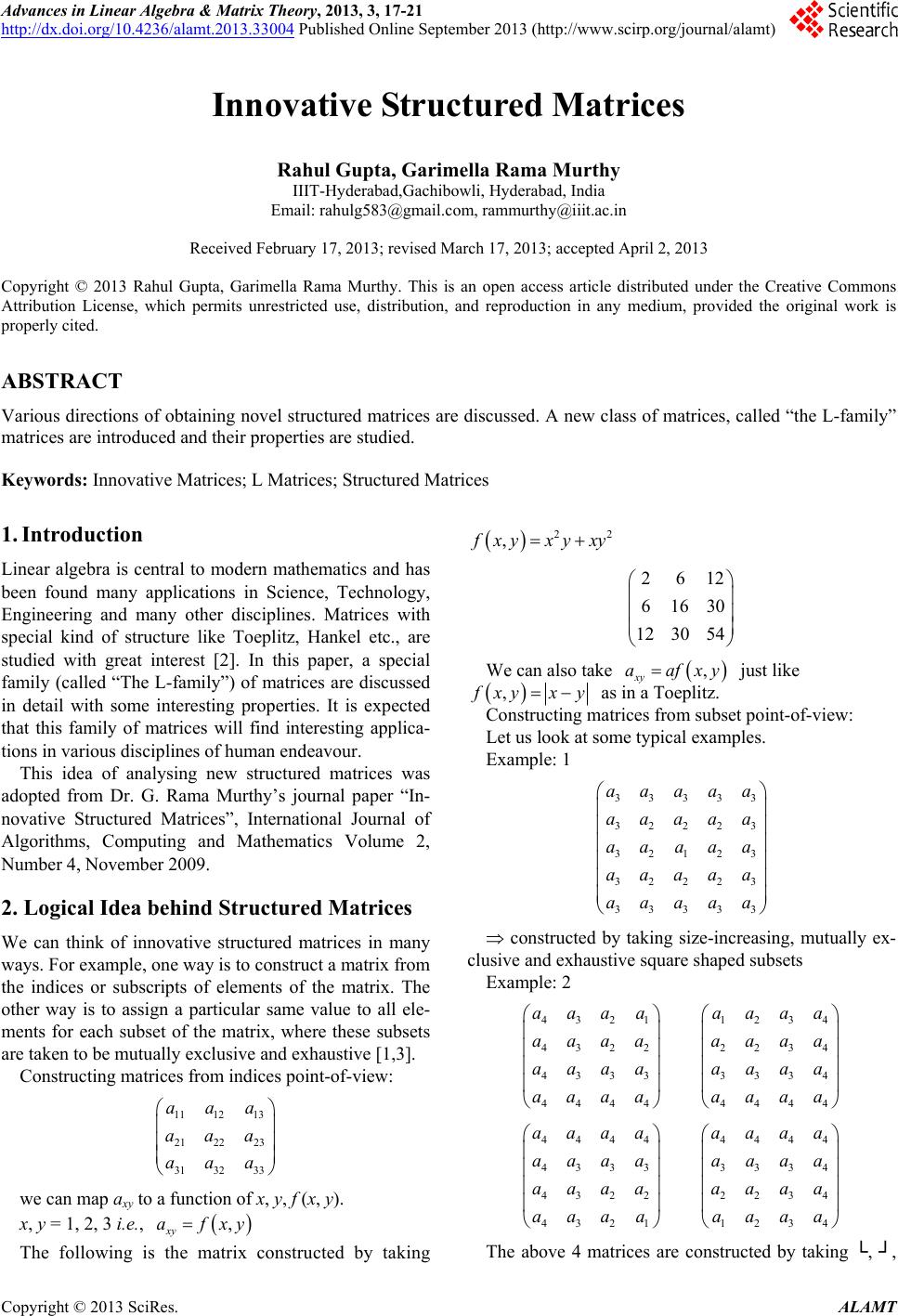 Advances in Linear Algebra & Matrix Theory, 2013, 3, 17-21 http://dx.doi.org/10.4236/alamt.2013.33004 Published Online September 2013 (http://www.scirp.org/journal/alamt) Innovative Structured Matrices Rahul Gupta, Garimella Rama Murthy IIIT-Hyderabad,Gachibowli, Hyderabad, India Email: rahulg583@gmail.com, rammurthy@iiit.ac.in Received February 17, 2013; revised March 17, 2013; accepted April 2, 2013 Copyright © 2013 Rahul Gupta, Garimella Rama Murthy. This is an open access article distributed under the Creative Commons Attribution License, which permits unrestricted use, distribution, and reproduction in any medium, provided the original work is properly cited. ABSTRACT Various directions of obtaining novel structured matrices are discussed. A new class of matrices, called “the L-family” matrices are introduced and their properties are studied. Keywords: Innovative Matrices; L Matrices; Structured Matrices 1. Introduction Linear algebra is central to modern mathematics and has been found many applications in Science, Technology, Engineering and many other disciplines. Matrices with special kind of structure like Toeplitz, Hankel etc., are studied with great interest [2]. In this paper, a special family (called “The L-family”) of matrices are discussed in detail with some interesting properties. It is expected that this family of matrices will find interesting applica- tions in various disciplines of human endeavour. This idea of analysing new structured matrices was adopted from Dr. G. Rama Murthy’s journal paper “In- novative Structured Matrices”, International Journal of Algorithms, Computing and Mathematics Volume 2, Number 4, November 2009. 2. Logical Idea behind Structured Matrices We can think of innovative structured matrices in many ways. For example, one way is to construct a matrix from the indices or subscripts of elements of the matrix. The other way is to assign a particular same value to all ele- ments for each subset of the matrix, where these subsets are taken to be mutually exclusive and exhaustive [1,3]. Constructing matrices from indices point-of-view: 11 1213 21 2223 31 3233 aaa aaa aaa we can map axy to a function of x, y, f (x, y). x, y = 1, 2, 3 i.e., , xy afxy The following is the matrix constructed by taking 22 , f xyxy xy 2612 61630 12 30 54 We can also take just like , xy aafxy , f xyx y as in a Toeplitz. Constructing matrices from subset point-of-view: Let us look at some typical examples. Example: 1 33333 32223 32123 32223 33333 aaaaa aaaaa aaaaa aaaaa aaaaa constructed by taking size-increasing, mutually ex- clusive and exhaustive square shaped subsets Example: 2 4321 4322 4333 4444 aaaa aaaa aaaa aaaa 1234 2234 3334 4444 aaaa aaaa aaaa aaaa 4444 4333 4322 4321 aaaa aaaa aaaa aaaa 4444 3334 2234 1234 aaaa aaaa aaaa aaaa The above 4 matrices are constructed by taking └, ┘, C opyright © 2013 SciRes. ALAMT 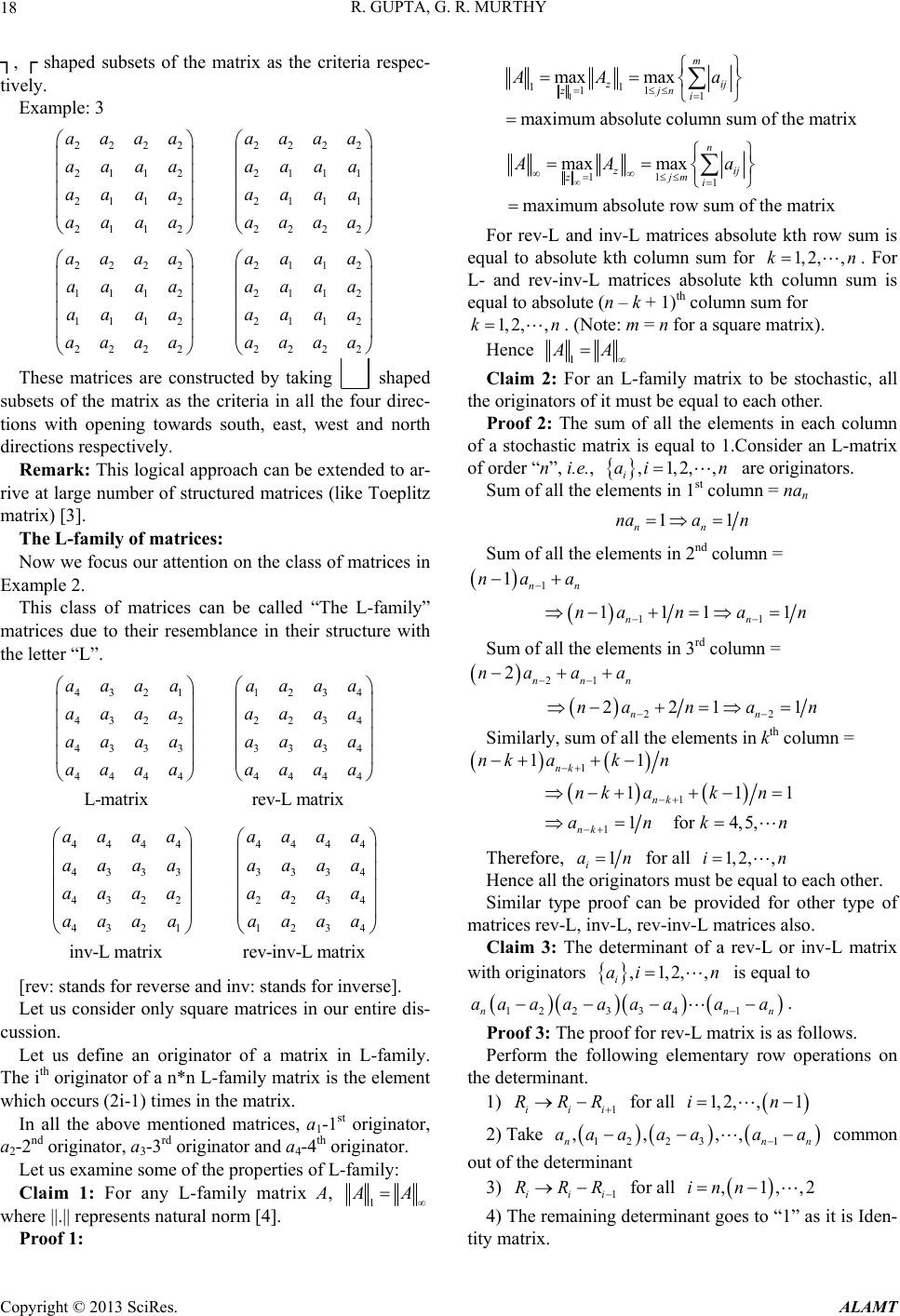 R. GUPTA, G. R. MURTHY 18 ┐, ┌ shaped subsets of the matrix as the criteria respec- tively. Example: 3 2222 2112 2112 2112 aaaa aaaa aaaa aaaa 2222 2111 2111 2222 aaaa aaaa aaaa aaaa 2222 1112 1112 2222 aaaa aaaa aaaa aaaa 2112 2112 2112 2222 aaaa aaaa aaaa aaaa These matrices are constructed by taking shaped subsets of the matrix as the criteria in all the four direc- tions with opening towards south, east, west and north directions respectively. Remark: This logical approach can be extended to ar- rive at large number of structured matrices (like Toeplitz matrix) [3]. The L-family of matrices: Now we focus our attention on the class of matrices in Example 2. This class of matrices can be called “The L-family” matrices due to their resemblance in their structure with the letter “L”. 4321 4322 4333 4444 L-matrix aaa a aaaa aaaa aaaa 1234 2234 3334 4444 rev-L matrix aaaa aaaa aaaa aaaa 4444 4333 4322 4321 inv-L matrix aaaa aaaa aaaa aaa a 4444 3334 2234 1234 rev-inv-L matrix aaaa aaaa aaaa aaaa [rev: stands for reverse and inv: stands for inverse]. Let us consider only square matrices in our entire dis- cussion. Let us define an originator of a matrix in L-family. The ith originator of a n*n L-family matrix is the element which occurs (2i-1) times in the matrix. In all the above mentioned matrices, a1-1st originator, a2-2nd originator, a3-3rd originator and a4-4th originator. Let us examine some of the properties of L-family: Claim 1: For any L-family matrix A, 1 A A where ||.|| represents natural norm [4]. Proof 1: 1 11 11 1 max max maximum absolute column sum of the matrix m zij zjn i AA a 11 1 max max maximum absolute row sum of the matrix n zij zjm i AA a For rev-L and inv-L matrices absolute kth row sum is equal to absolute kth column sum for . For L- and rev-inv-L matrices absolute kth column sum is equal to absolute (n ‒ k + 1)th column sum for 1, 2,,kn 1, 2,,kn . (Note: m = n for a square matrix). Hence 1 A A Claim 2: For an L-family matrix to be stochastic, all the originators of it must be equal to each other. Proof 2: The sum of all the elements in each column of a stochastic matrix is equal to 1.Consider an L-matrix of order “n”, i.e., ,1,2,, i ai n are originators. Sum of all the elements in 1st column = nan 11 nn naa n Sum of all the elements in 2nd column = 1 1nn na a 11 111 1 nn na na n Sum of all the elements in 3rd column = 21 2nn naaa n 22 221 1 nn nan a n S imilarly, sum of all the elements in kth column = 1 11 nk nk akn 1 1 11 1for4,5, nk nk nk akn ank 1 n Therefore, 1 i an for all in 1, 2,, Hence all the originators must be equal to each other. Similar type proof can be provided for other type of matrices rev-L, inv-L, rev-inv-L matrices also. Claim 3: The determinant of a rev-L or inv-L matrix with originators ,1,2,, i ai n is equal to 122334 1nn aa aaa aaaa n . Proof 3: The proof for rev-L matrix is as follows. Perform the following elementary row operations on the determinant. 1) 1iii RRR for all in 1, 2,,1 2) Take 12 231 ,,aaa aaa ,, n ammon out of the determinant nn co 3) 1iii RRR for all in ,1,,n2 4) The remaining determinant goes to “1” as it is Iden- tity matrix. Copyright © 2013 SciRes. ALAMT 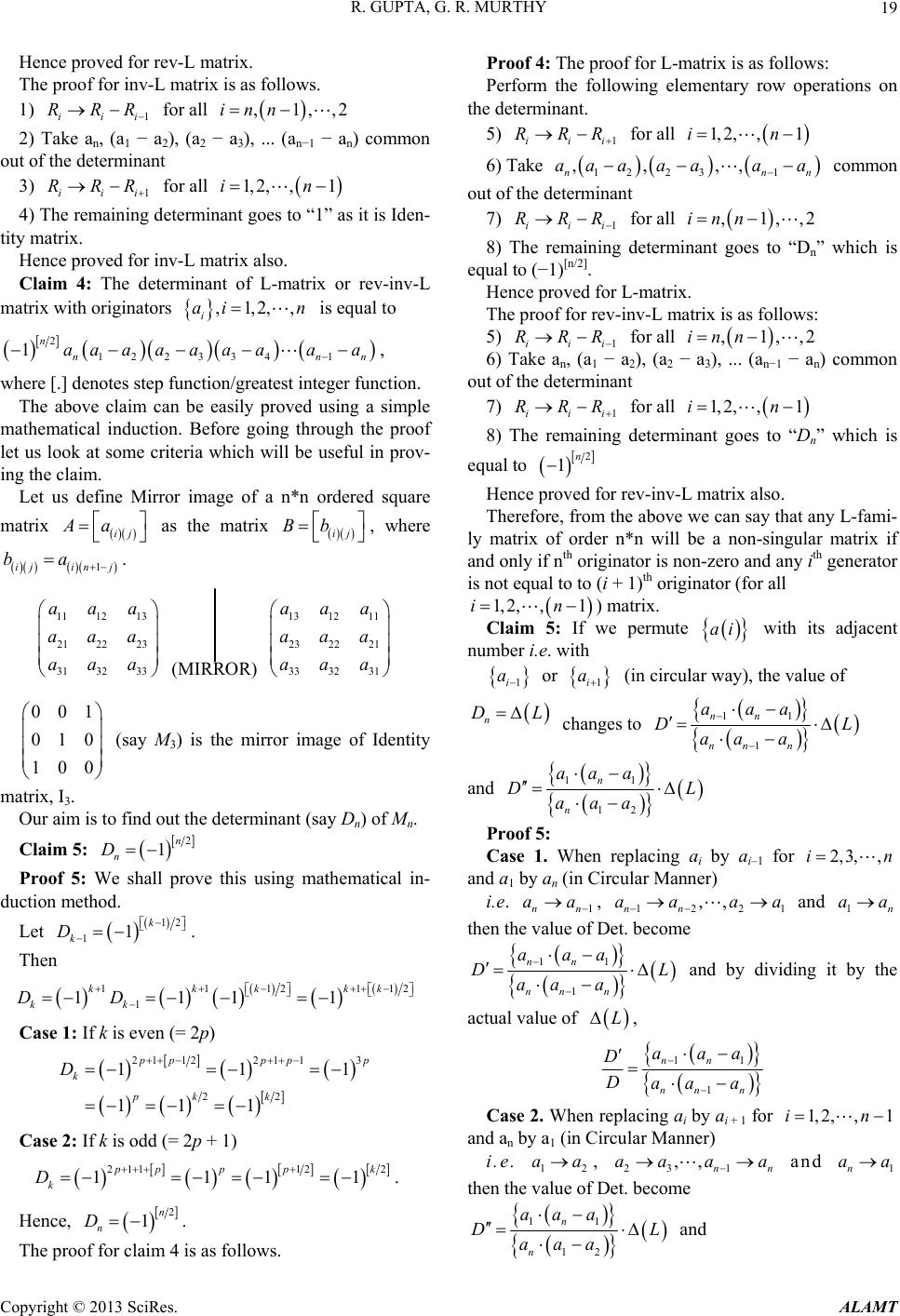 R. GUPTA, G. R. MURTHY 19 Hence proved for rev-L matrix. The proof for inv-L matrix is as follows. 1) for all 1iii RRR ,1,,inn2 2) Take an, (a1 − a2), (a2 − a3), ... (an−1 − an) common out of the determinant 3) for all 1iii RRR 1, 2,,1in 4) The remaining determinant goes to “1” as it is Iden- tity matrix. Hence proved for inv-L matrix also. Claim 4: The determinant of L-matrix or rev-inv-L matrix with originators ,1,2,, i ai n is equal to 2 122334 1 1n n aa aaaaaaa n n , where [.] denotes step function/greatest integer function. The above claim can be easily proved using a simple mathematical induction. Before going through the proof let us look at some criteria which will be useful in prov- ing the claim. Let us define Mirror image of a n*n ordered square matrix as the matrix , where . ij Aa 1in j ba ij Bb ij (MIRROR) 1112131312 11 21 2223232221 31 32 3333 3231 aaa aaa aaaaaa aaa aaa 001 010 100 (say M3) is the mirror image of Identity matrix, I3. Our aim is to find out the determinant (say Dn) of Mn. Claim 5: 2 1n n D Proof 5: We shall prove this using mathematical in- duction method. Let 12 11k k D . Then 11121 1 1111 kkkk kk DD 12k Case 1: If k is even (= 2p) 211221 13 22 11 11 1 pppp p k pk k D 1 Case 2: If k is odd (= 2p + 1) 211122 111 pppp k D 1 k . Hence, 2 1n n D . The proof for claim 4 is as follows. Proof 4: The proof for L-matrix is as follows: Perform the following elementary row operations on the determinant. 5) 1iii RRR for all 1, 2,,1in 6) Take 12 231 ,,,,aaa aaa n ammon out of the determinant nn co 7) 1iii RRR for all ,1,,inn2 8) The remaining determinant goes to “Dn” which is equal to (−1)[n/2]. Hence proved for L-matrix. The proof for rev-inv-L matrix is as follows: 5) 1iii RRR for all ,1,,inn2 6) Take an, (a1 − a2), (a2 − a3), ... (an−1 − an) common out of the determinant 7) 1iii RRR for all 1, 2,,1in 8) The remaining determinant goes to “Dn” which is equal to 2 1n Hence proved for rev-inv-L matrix also. Therefore, from the above we can say that any L-fami- ly matrix of order n*n will be a non-singular matrix if and only if nth originator is non-zero and any ith generator is not equal to to (i + 1)th originator (for all 1, 2,,1in ) matrix. Claim 5: If we permute ai with its adjacent number i.e. with 1i a or 1i a (in circular way), the value of DL n changes to 11 1 nn nn n aaa DL aa a and 11 12 n n aaa DL aaa Proof 5: Case 1. When replacing ai by ai‒1 for 2,3, ,in and a1 by an (in Circular Manner) i.e. 1nn aa , and 122 ,, nn aa a 1 a1n aa then the value of Det. become 11 1 nn nn n aaa D aa a L and by dividing it by the actual value of L, 11 1 nn nnn aaa D Daa a Case 2. When replacing ai by ai + 1 for and an by a1 (in Circular Manner) 1, 2,,1in i.e. , and 12 aa23 1 ,, n aa aa n 1n aa then the value of Det. become 11 12 n n aaa DL aaa and Copyright © 2013 SciRes. ALAMT 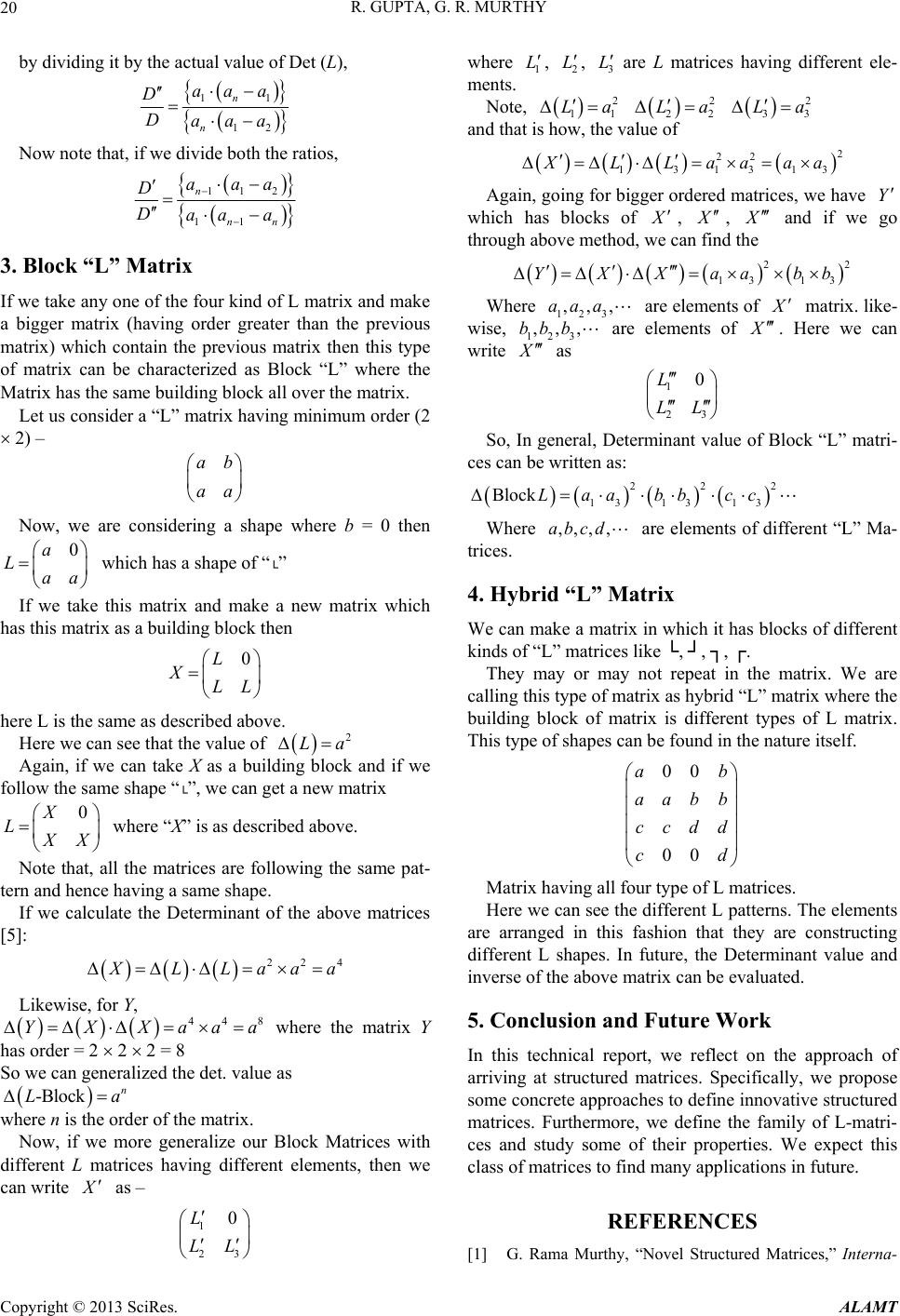 R. GUPTA, G. R. MURTHY 20 by dividing it by the actual value of Det (L), 11 12 n n aaa D Daaa Now note that, if we divide both the ratios, 11 2 11 n nn aaa D Daa a 3. Block “L” Matrix If we take any one of the four kind of L matrix and make a bigger matrix (having order greater than the previous matrix) which contain the previous matrix then this type of matrix can be characterized as Block “L” where the Matrix has the same building block all over the matrix. Let us consider a “L” matrix having minimum order (2 2) – ab aa Now, we are considering a shape where b = 0 then 0a Laa which has a shape of “└” If we take this matrix and make a new matrix which has this matrix as a building block then 0L XLL here L is the same as described above. Here we can see that the value of 2 La Again, if we can take X as a building block and if we follow the same shape “└”, we can get a new matrix 0X L X X 4 where “X” is as described above. Note that, all the matrices are following the same pat- tern and hence having a same shape. If we calculate the Determinant of the above matrices [5]: 22 X LLaaa Likewise, for Y, 44 YXXaa 8 a where the matrix Y has order = 2 2 2 = 8 So we can generalized the det. value as -Block n La where n is the order of the matrix. Now, if we more generalize our Block Matrices with different L matrices having different elements, then we can write X as – 1 23 0L LL where 1 L , 2 L , 3 L are L matrices having different ele- ments. Note, 2 11 La 2 22 La 2 33 La and that is how, the value of 2 22 131313 XLLaaaa Again, going for bigger ordered matrices, we have Y which has blocks of X , X , X and if we go through above method, we can find the 22 13 13 YXXaabb Where are elements of 123 ,,,aaa X matrix. like- wise, are elements of 123 ,,,bbb X . Here we can write X as 1 23 0L LL So, In general, Determinant value of Block “L” matri- ces can be written as: 222 13 13 13 Block Laabbcc Where are elements of different “L” Ma- trices. ,,, ,abcd 4. Hybrid “L” Matrix We can make a matrix in which it has blocks of different kinds of “L” matrices like └, ┘, ┐, ┌. They may or may not repeat in the matrix. We are calling this type of matrix as hybrid “L” matrix where the building block of matrix is different types of L matrix. This type of shapes can be found in the nature itself. 00 00 ab aa bb ccdd cd Matrix having all four type of L matrices. Here we can see the different L patterns. The elements are arranged in this fashion that they are constructing different L shapes. In future, the Determinant value and inverse of the above matrix can be evaluated. 5. Conclusion and Future Work In this technical report, we reflect on the approach of arriving at structured matrices. Specifically, we propose some concrete approaches to define innovative structured matrices. Furthermore, we define the family of L-matri- ces and study some of their properties. We expect this class of matrices to find many applications in future. REFERENCES [1] G. Rama Murthy, “Novel Structured Matrices,” Interna- Copyright © 2013 SciRes. ALAMT 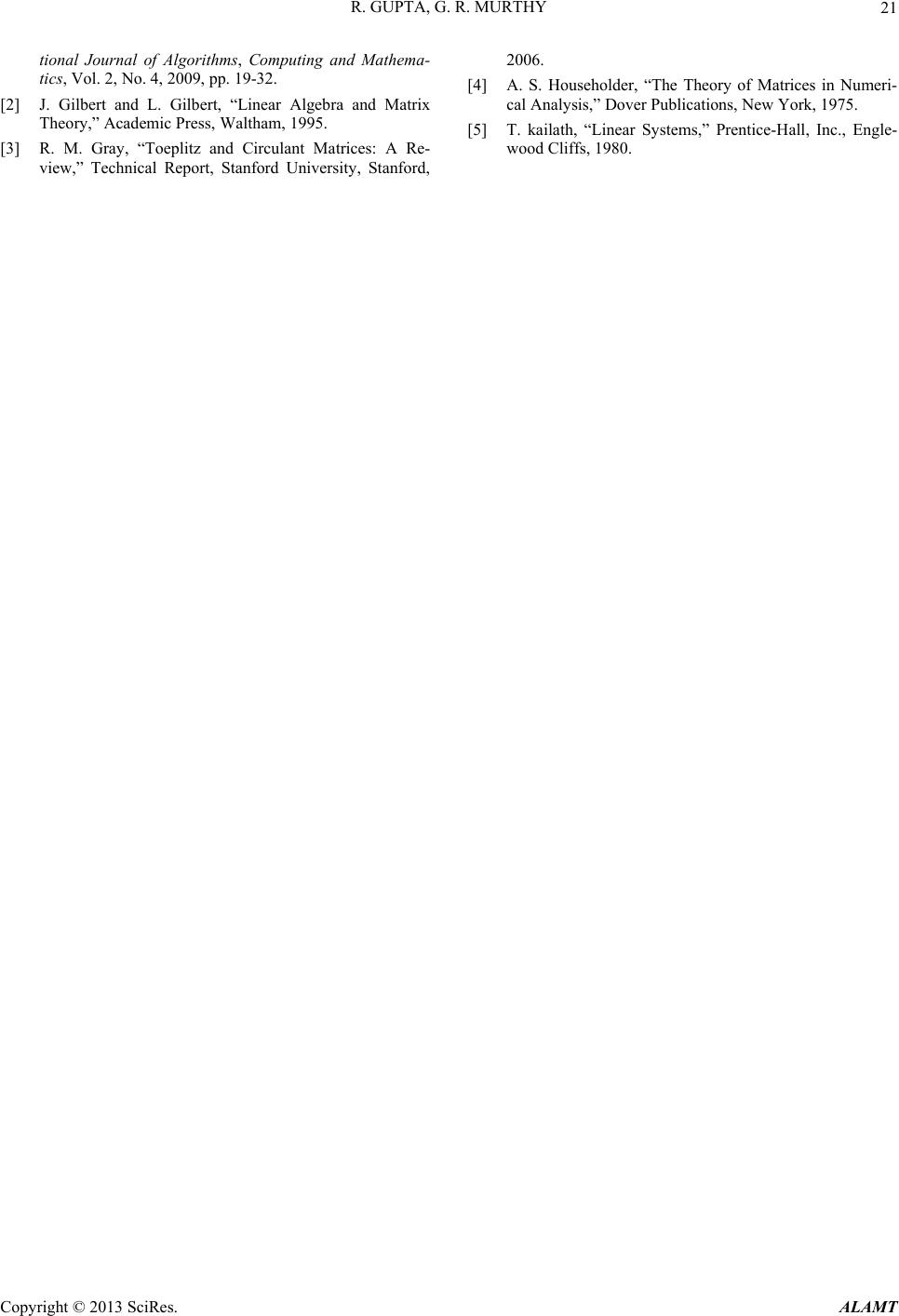 R. GUPTA, G. R. MURTHY Copyright © 2013 SciRes. ALAMT 21 tional Journal of Algorithms, Computing and Mathema- tics, Vol. 2, No. 4, 2009, pp. 19-32. [2] J. Gilbert and L. Gilbert, “Linear Algebra and Matrix Theory,” Academic Press, Waltham, 1995. [3] R. M. Gray, “Toeplitz and Circulant Matrices: A Re- view,” Technical Report, Stanford University, Stanford, 2006. [4] A. S. Householder, “The Theory of Matrices in Numeri- cal Analysis,” Dover Publications, New York, 1975. [5] T. kailath, “Linear Systems,” Prentice-Hall, Inc., Engle- wood Cliffs, 1980. |

